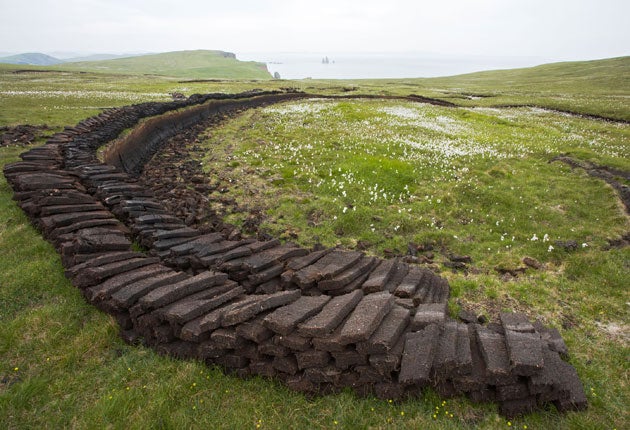Oil company to store peat bog for 30 years

A moorland peatbog is to be dug up wholesale and put into storage for more than 30 years in an unprecedented measure to protect it from destruction. The peatbog on Shetland is in the way of a gas processing facility which is to be built as an extension to the Sullom Voe oil terminal on the island.
The oil company Total has agreed, as part of the deal to be allowed to build the £500m gas facility, to store the peat so that it can be returned at the end of the plant's operational life.
It's estimated that more than 260,000 cubic metres of peat – enough to fill 100 Olympic swimming pools – will have to be cut out and moved away to be piled up in "peat terraces" and covered with a layer of vegetation to protect them from drying out.
Peat bogs are an increasingly rare feature of the British and European landscapes because so many have been drained to turn them into agricultural land. Others have been dug up for the gardening industry.
They are formed over many years as layer upon layer of vegetation dies and is covered up by more plants. Because of the low oxygen levels the dead plant material is preserved rather than decomposing, which means that peat stores huge quantities of carbon and when burned or broken up releases it back into the atmosphere, contributing to global warming. Peatlands are calculated to lock in twice as much carbon as forests, despite covering just 3 per cent of the land.
Brian O'Neill, a spokesman for Total, said the peat would be kept in conditions as close to their natural state as possible. "It will be wetted by the rain and drain in a similar way as it would naturally, which should ensure it is maintained in the same kind of wet anoroebic conditions as in nature," he said. "The condition of the peat in the stores will be monitored through the life of the plant to ensure it remains in a suitable condition to be used for site restoration."
The International Peat Society, which monitors peatlands across the globe amid concerns they are disappearing, welcomed the innovative decision by Shetland Islands Council to insist on the peat being stored rather than destroyed.
There remains, however, uncertainty about whether the peat, which will be stored within the perimeter of the gas plant, will survive the process. A report by the council cautioned: "There is no absolute certainty that the peat will be suitable for site restoration at the end of the gas plant's life."
The new gas facility, which it is estimated will be operational for 30 to 35 years, is intended as a staging post for gas piped from fields that are to be drilled west of the Shetlands. Once processed at Sullom Voe, the gas will be piped to the St Fergus terminal near Peterhead and then put into the national gas grid.
Andrew Cougar, of Scottish Natural Heritage, described peatbogs as an "incredibly important" part of the landscape and said: "There is a real rarity value to the Scottish peatlands. But because it seems we have so much of it here in Scotland we may tend to take it for granted."
Peatlands are home to wildlife including birds such as red-throated divers and whimbrels. Only a tiny fraction of Britain's ancient peatlands remain because of extraction, drainage, erosion and overgrazing. Peatbogs contain so much water that when drained the ground level can slump by several feet. Sphagnum moss, a common component of the vegetation covering peat, can contain 20 times its own weight in water.
Climate change campaigners have called for peatlands and other wetlands to be protected because of their value in acting as carbon sinks. Emergency measures have been taken in some parts of the country to protect peat bogs, including the Peak District where eroded areas are re-seeded.
Join our commenting forum
Join thought-provoking conversations, follow other Independent readers and see their replies
Comments
Bookmark popover
Removed from bookmarks